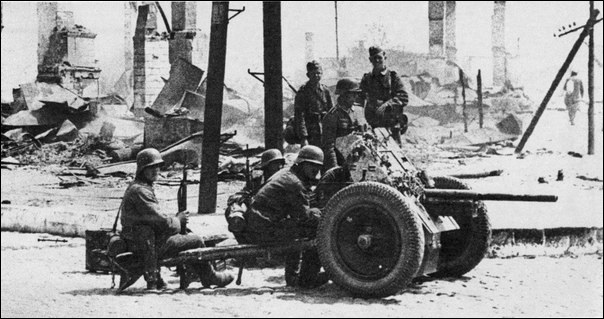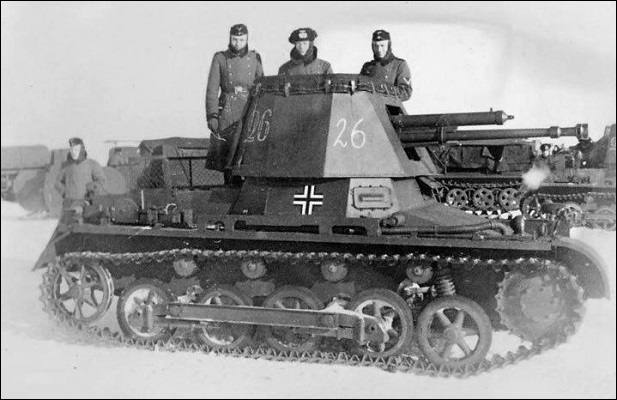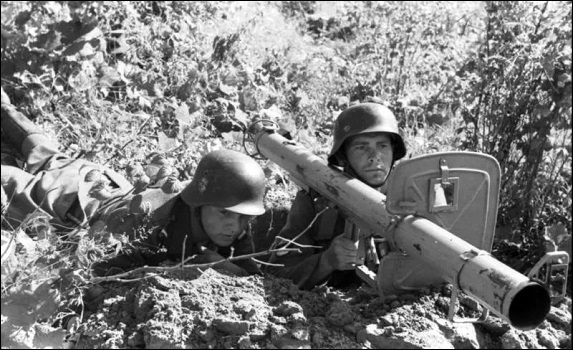The
divisional antitank battalion was called the Panzer-Abwehr-Abeiling
(motorisiert),
retitled to Panzerjäger-Abteilung
(motorisiert) in early
1940). Panzerjäger (lit. tank hunter) was also
the name given to self-propelled tank destroyers, e.g. the Panzerjäger I.
Late n the war, Panzerjäger was the term used for
tank destroyers with an open-topped fighting compartment,
while Jagdpanzer (hunting tank) was the term used for
those with an enclosed fighting compartment, like the
Jagdpanzer IV.
The “L” designation applied to 37mm
and larger antitank guns indicated barrel length; the longer the
barrel, the higher the muzzle velocity of the gun and the
greater its ability to penetrate armor.
● ● ●
At the
beginning of the war all divisions of the German Army had a
motorized antitank (AT) battalion, and its authorized organization was
the same for all division types. The AT battalion had a headquarters company, three AT companies and (most
infantry divisions of the 1st Wave and most
panzer, light and motorized divisions) one flak (antiaircraft
or AA)
company. The AT companies each had 12 x 37mm L/45 AT guns (motor
towed) and the flak company had 12 x 20mm AA guns
(halftrack towed).
The AT
battalion's weak spot was its main weapon, the 37mm gun. In
1939 it was capable of destroying any light tank and could
disable most others, but the trend toward larger tanks with
thicker armor was soon to render the 37mm gun obsolete.
During the 1940 campaign in the West, it proved ineffective
against the British Matilda infantry tank and the French
Char B heavy tank. Accordingly, the 50mm L/60 AT gun was designed
and large numbers of captured Belgian, Czech and French 47mm
AT guns were pressed into service. By the time of the
invasion of the USSR, a few AT battalions of infantry
divisions had two companies with 47mm guns and one with 37mm
guns. But thanks to personnel and equipment shortages,
divisional AT battalions now varied in composition. Those of
the
infantry divisions lost their
flak company and sometimes
had only two AT companies. In a few divisions there was no
AT battalion at all, just a single company.

The 37mm PAK 36 antitank
gun (Photo: Bundesarchiv)
The AT
battalions of
motorized infantry divisions
all had three AT companies and about half retained the flak
company. The AT
companies had one platoon with three 50mm guns and two with
four 37mm guns each. Most of the
panzer divisions
had a similar AT battalion and with two or three exceptions
they all included the flak company, which was now
self-propelled, the guns being mounted on trucks or
halftracks.
Early
combat operations revealed that motor-towed antitank guns
had some tactical shortcomings. They were considerably less
mobile than tanks, besides being vulnerable to artillery,
tank and even small-arms fire. To be effective the towed
guns had to be sited in carefully chosen positions and
provided with infantry support. Because they engaged enemy
tanks by line of sight at short ranges, the AT battalions’
losses tended to be high. The obvious solution was to give
the AT gun more mobility and protection and this the Germans
did with the Panzerjäger (tank hunter), a tracked,
self-propelled (SP) tank destroyer with light armor. The
first such vehicle, called the
Panzerjäger I, mounted the
Czech 47mm L/43 AT gun on the chassis of the obsolete Panzer I
light tank. The gun was installed in an open-topped, lightly
armored fighting
compartment with limited traverse. The Panzerjäger I entered
service in 1940, saw action in France, North Africa and
Russia, and though this improvised tank destroyer had
various deficiencies, it pointed the way forward.

The Panzerjäger I tank
destroyer, armed with the captured Czech 47mm antitank gun
(World War Photos)
By late
1942-early 1943 the AT battalions of most motorized and
panzer divisions, and also a few infantry divisions,
included a company equipped with various models of the Panzerjäger Marder SP tank destroyer. These vehicles had the same layout
as the Panzerjäger I but were built on the chassis of either
the Panzer II or Panzer 38(t) tank, or the Lorraine 37L
armored artillery tractor, of which some 300 had been
captured from the French Army in 1940. They were armed with
either the new German 75mm L/48 AT gun or the Russian 76.2mm
L/48
field gun, which had been captured in large numbers, proved
adaptable to the AT role and was easily modified to fire
German ammunition. The other two companies had the towed
50mm gun and were scheduled to receive the towed version of
the 75mm L/48 gun. But this weapon was in such high demand that
it proved impossible replace the 50mm gun entirely. The AT
battalions of most infantry divisions had towed guns—if
possible two companies with 50mm guns and one with 75mm
guns. But here again shortages prevented standardization and
the infantry divisions made do with what was available.
The Type
1944 Infanterie-Division and the
Volksgrenadier-Division (1944-45) had a standard antitank battalion with
one SP tank destroyer company, one towed AT company armed
with 75mm guns and one SP flak company armed with 37mm guns. The
SP company was equipped with either the
Sturmgeschütz III assault
gun or the Jagdpanzer 38 (Hetzer) tank destroyer. The former was an armored
vehicle based on the chassis of the Panzer III or Panzer IV
tank. It had been developed originally as an infantry
support weapon with a short-barreled 75mm L/24 gun housed in a
fully enclosed armored compartment with limited traverse.
This layout proved ideal for the AT role and when armed with
the 75mm L/43 or L/43 AT gun the StuG III and IV came to be employed as
an SP tank destroyer in many panzer, infantry and VG division AT
battalions. The Hetzer, based on the Panzer 38(t) and armed with the 75mm
L/48 AT gun in an enclosed fighting compartment, was also employed in large
numbers. In the war's final months, equipment shortages were
often made up by pressing the obsolescent Marders back into
service.
Early in the war infantry
regiments had a separate motorized antitank company
identical to those in the divisional AT battalion, with 12 x
37mm ATG. In some divisions raised between 1940 and 1942,
however, it was only possible to provide a regimental AT
platoon (3 x 37mm ATG). The 50mm and 75mm ATG gradually
replaced the 37mm in these regimental AT units but
production was unable to keep up with demand and in the Type
1944 Grenadier-Regiment the AT company had three platoons:
one with 3 x 75mm ATG and two with 18 x
Raketenpanzerbüchse
54
antitank rocket launchers (ATRL) each. The latter was
similar to the US bazooka but larger and more powerful (88mm
caliber versus 60mm for the US version). In the Volksgrenadier-Regiment
the 75mm guns were deleted, the AT company having three
platoons with a total of 54 x ATRL. The Type 1945
Grenadier-Regiment had the same ATRL company.

A Raketenpanzerbüchse
54 team in an ambush position (Photo: Bundesarchiv)
Late-war
panzer division AT battalions were authorized three
companies: two with SP tank destroyers and one with twelve towed
75mm AT guns. The SP companies were equipped with either the
Jagdpanzer
IV, a
tank destroyer based on the Panzer IV tank, armed with a
75mm L/70 gun or the StuG III or IV, or the Hetzer. That, at any rate was the
standard but by late 1944 faltering production and the
collapse of the transportation system made it increasingly
difficult for the German Army to maintain any of its combat
units at authorized strength.
● ● ●